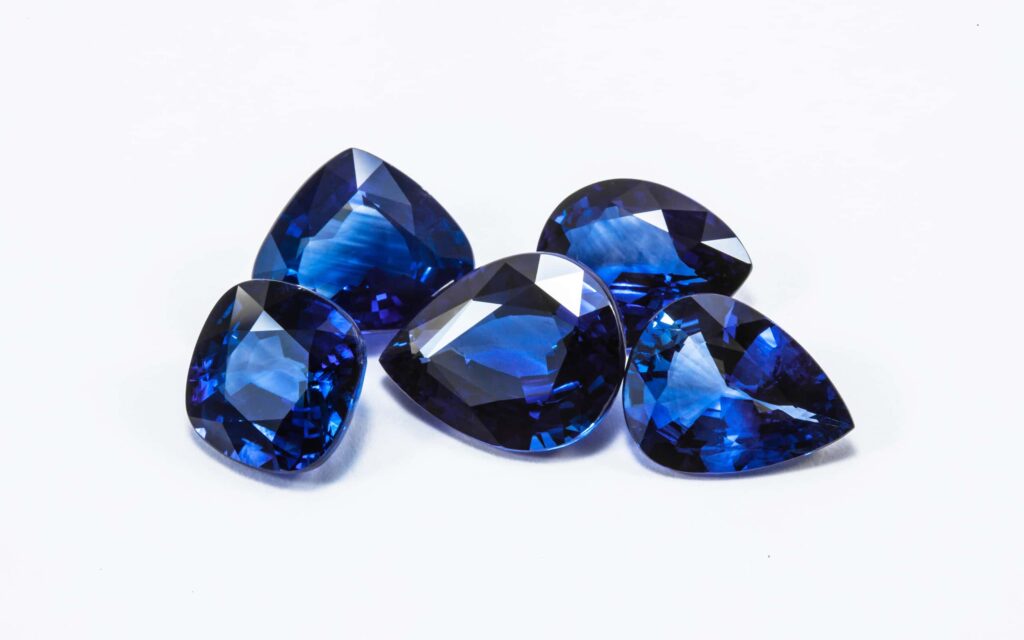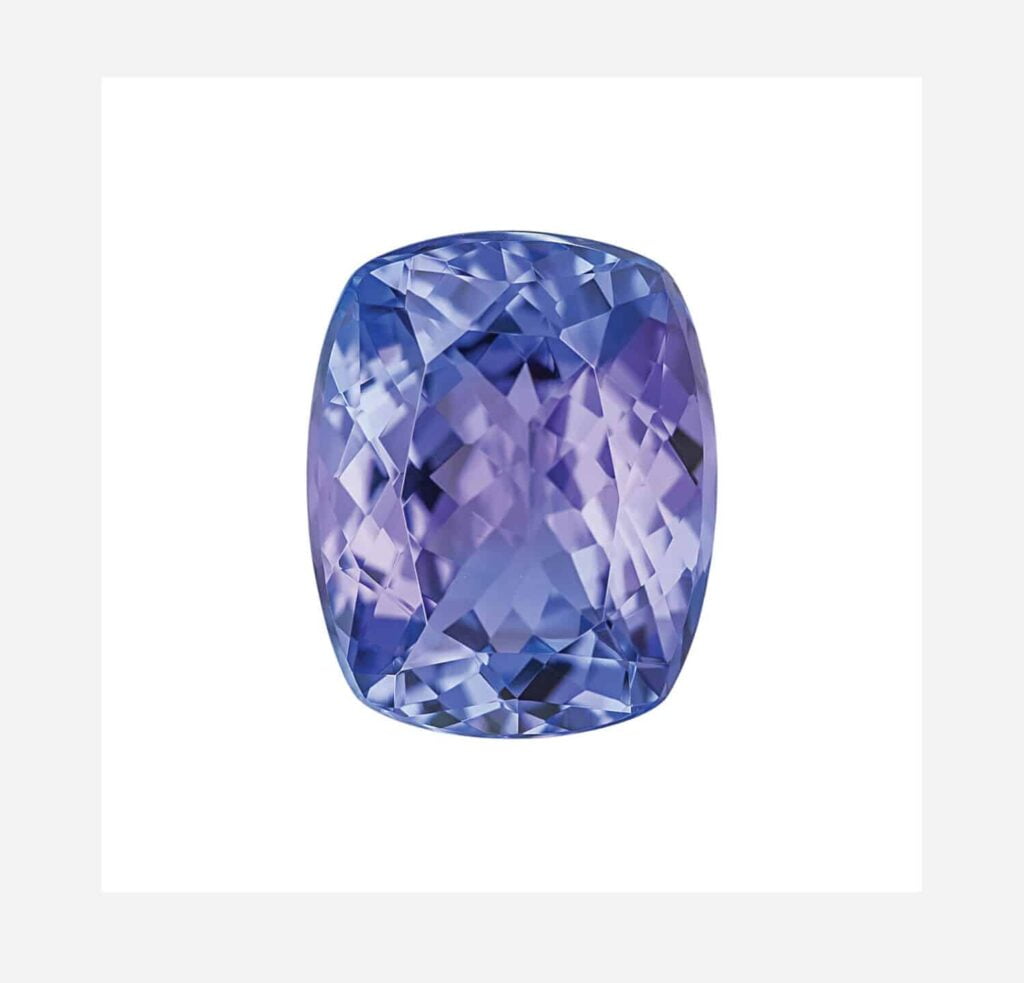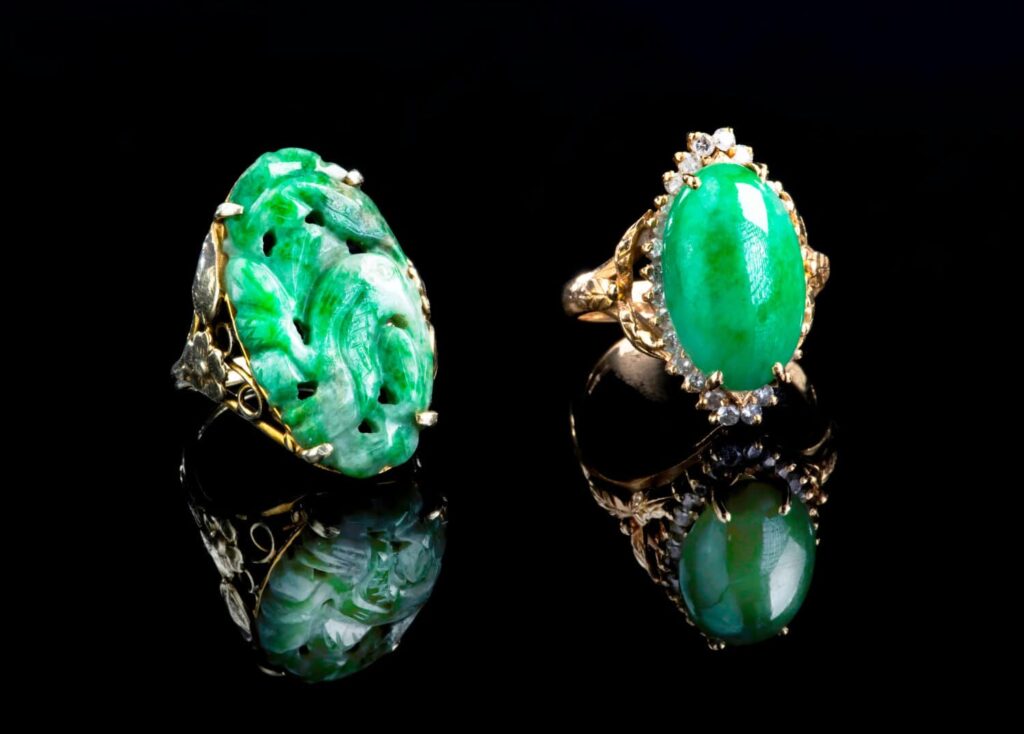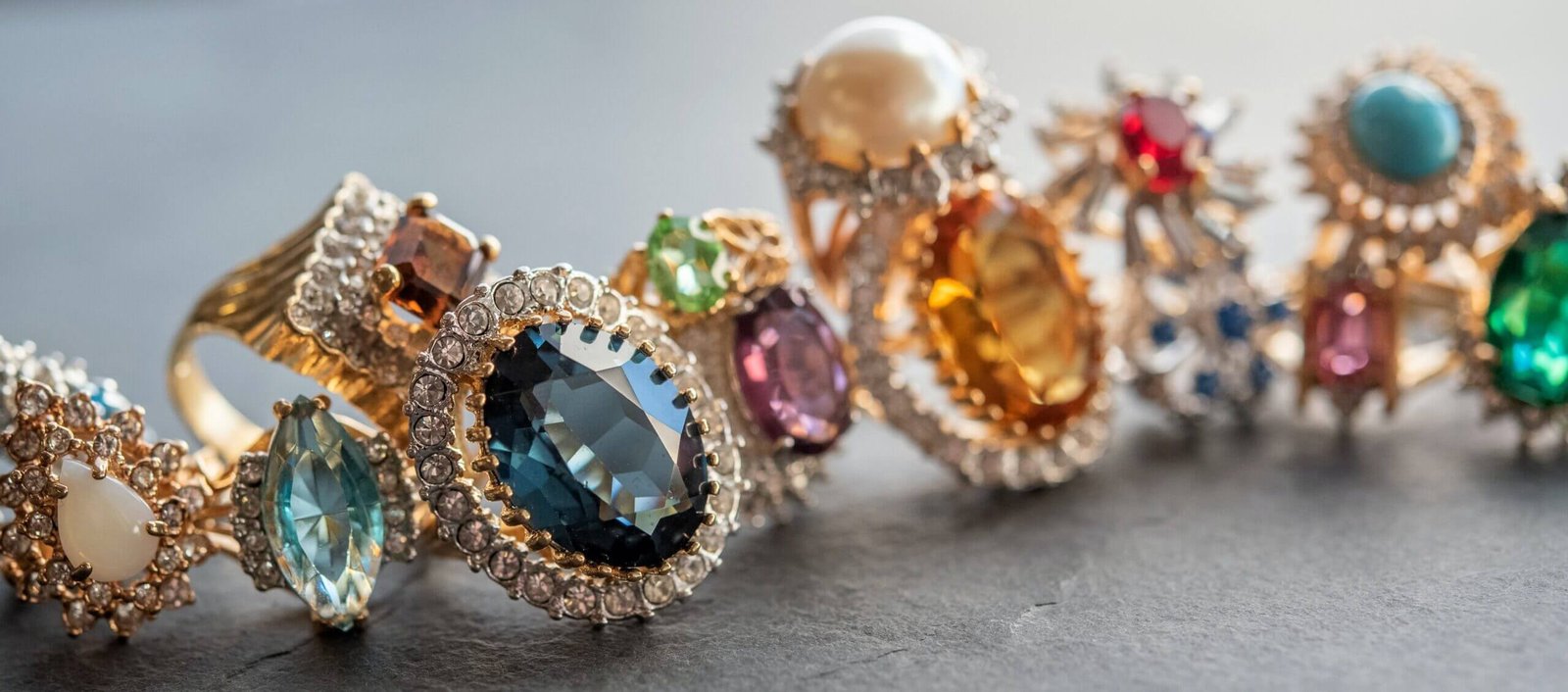Immerse yourself in the alluring world of gemstones, far beyond the typical glitter of diamonds. Indeed, while ever popular, diamonds aren’t as rare as you might think, with the true standout quality being their remarkable hardness. Instead, broaden your spectrum to embrace the bright minty green polish of Paraiba Tourmaline, the richest shades of blue Tanzanite that change with the light, or Jadeite’s emerald green allure. Be stirred by the extreme rarity and velvet blue richness of Kashmir Sapphires, or the luck, fortune, and healing associated with the refracting Taafeite. You may be intrigued by grandidierite, sourced from a handful of globes’ pockets, the vibrant red “pigeon blood” Burmese Rubies, or the captivating Alexandrite stones that change color with shifting light. Dive deeper into rarities such as Dark Blue Aquamarine, the enchanting pink-orange hues of Padparadscha Sapphire, or the iridescent Ammolite, a relic from mollusk shells over 65 million years ago. Embrace the uniqueness and rarity of these gems; each holds a different story to explore.

Understanding the Uniqueness and Rarity of Diamonds
Defining the Rarity and Uniqueness of Diamonds
Rare gemstones, such as diamonds, are often sought after for their beauty and perceived value. Diamonds, in particular, have always been synonymous with rarity, but they aren’t as rare as jewelry companies represent them to be. Their uniqueness, however, lies in their exceptional hardness, which surpasses all other gemstones.
Factors Contributing to the Rarity of Diamonds
The rarity of diamonds is often associated with their availability or scarcity. Diamonds are only formed under intense heat and pressure conditions deep within the Earth’s mantle. Their journey to the surface is a complex process involving volcanic activity, making them less prevalent than other gems.
Understanding the Unmatched Hardness of Diamonds
Diamonds are renowned for their unmatched hardness. They are rated 10 on the Mohs hardness scale, the highest possible rating, which makes them extremely resilient to scratches and abrasions. This hardness contributes significantly to their appeal, mystique, and perceived rarity.
Exploring Other Rare Gemstones
Understanding the Rarity of Paraiba Tourmaline
On par with diamonds in terms of rarity, Paraiba Tourmaline is the rarest form of tourmaline. It displays a beautiful bright, minty green when polished. This gem can fetch upwards of $20,000 per carat, reflecting its uncommon nature.
Tanzanite: A Rare Find from Tanzania
Tanzanite is a captivating gemstone that is only found in Tanzania, its namesake. This exquisite gem is admired for its rich deep blue color that subtly changes shades as different lighting strikes the stone, adding to its rarity and allure.
The Uniqueness and Rarity of Jadeite
Jadeite, a variant of Jade, is more resilient and rare. It’s particularly in demand when it showcases an emerald green hue and is slightly translucent. The hardness and scarcity of Jadeite contribute to its esteemed value compared to traditional Jade.
Kashmir Sapphire: A Sought After Gem
Kashmir Sapphires are renowned for their velvet blue color. Their high demand and limited supply make them an extraordinarily rare find. Their unique hue often leads to confusion with Sri Lankan sapphires, further sparking interest in these rare treasures.
The Ultra Rares: Taaffeite and Grandidierite
Taaffeite and Grandidierite are two of the rarest gemstones, surpassing even diamonds in their scarcity. Taaffeite is recognized for its light refraction and unique association with luck and healing. Grandidierite is equally intriguing, found only in specific locations globally, with quality cuts primarily sourced from Madagascar.
Burmese Rubies: The ‘Pigeon Blood’ Phenomenon
Burmese Rubies, or “pigeon blood” rubies, are renowned for their deep and intense red color. Their exceptional hue reminds one of fresh blood—a feature that adds to their exciting rarity. This stunning gemstone hails from Burma, now known as Myanmar.
The Colour-Changing Phenomenon of Alexandrite Stones
Alexandrite stones possess a fascinating trait – they change color depending on light conditions. In daylight, they may appear peacock blue or emerald green, while under indoor lighting, this gem transforms to a captivating red or purple hue. This color-changing feature elevates its appeal and rarity.
Unveiling the Rarity of Dark Blue Aquamarine
While Aquamarine is relatively common, the dark blue variety is an extraordinary rarity. These magnificent gems are solely found in Brazil, increasing their desirability and value.
An Introduction to Padparadscha Sapphire
Known for their unique shades of pink or orange, the Padparadscha Sapphire stands among the rarest gemstones. Their alluring color spectrum adds an aura of mystery and desirability that gem enthusiasts can’t resist.
Diving into the Unique Qualities of Ammolite
Ammolite is a gem born from the shells of ancient mollusks that once resided in the prehistoric oceans over 65 million years ago. Found primarily in the Rocky Mountains, this gem mesmerizes with its stunning iridescent colors, adding to its distinctiveness and rarity.
Understanding Rarity in the Context of Demand and Supply
Defining Supply and Demand in the Gemstone Industry
Like any other industry, the gemstone market operates on the basic principles of supply and demand. The balance or imbalance of these two factors directly impacts rarity perception and the market prices of gems.
Role of Supply and Demand in Determining Rarity
Scarcity, coupled with high demand, can boost a gem’s rarity status and value. For instance, a gem that is abundant but has high demand still may not be considered rare. On the other hand, gems that are scarce and sought after, like diamonds and tourmalines, are identified as rare.
How Demand Influences the Price of Rare Gemstones
The principle of demand and supply plays a significant role in establishing gemstone prices. Higher demand coupled with limited supply can drive up prices, as seen with diamonds. Alternatively, even if a gemstone is rare but the demand is low, the prices would not reach high points.
The Making of a Diamond: Understanding the Formation Process
The Geological Process of Diamond Formation
Diamonds undergo a fascinating geological formation process. Originating deep within the Earth’s mantle under high-pressure and high-temperature conditions, diamonds are propelled towards the surface through volcanic activities.
Why the Diamond Formation Process is Unique
This formation process is exceptional and not shared by other gemstones, contributing to their distinctiveness. The unique conditions required for their formation not only make diamonds rare but also give them their extraordinary hardness.
Impact of the Process on the Rarity of Diamonds
The extensive and unique geological process that forms diamonds contributes to their relative scarcity, bolstering their reputation as rarities among gemstones.

Implications of Diamond Mining on Rarity
The Impact of Mining Techniques on Diamond Quantity
Mining techniques can vastly impact the quantity of diamonds made available in the market. Traditional techniques, though less intrusive, yield lower quantities. Modern methods, although more productive, can lead to faster exhaustion of diamond reserves, affecting future supplies and thus, their rarity.
How Artificial Techniques are Influencing the Rarity of Diamonds
The advent of artificial diamond production techniques, like high-pressure high-temperature (HPHT) and chemical vapor deposition (CVD), has also impacted the rarity of natural diamonds. As more synthetic diamonds enter the market, the rarity status of natural diamonds becomes more pronounced.
Role of Diamond Reserves in Enhancing or Diminishing Rarity
Diamond reserves worldwide have a profound impact on the rarity of this gemstone. If reserves are plentiful and easily accessible, the perceived rarity of diamonds might diminish. Conversely, if reserves are dwindling or difficult to mine, the rarity and value of diamonds increase.
Rarity and Its Relationship with Diamond Prices
How Rarity Influences Diamond Prices
Rarity is an essential factor that influences diamond prices. The rarer the diamond, the higher its market value. This principle applies to unusual colors in diamonds, like blue, green, or red, which are considered more scarce and therefore demand higher prices.
Understanding the Price Discrepancy in Rare and Common Diamonds
Not all diamonds hold the same value. More commonly available variants, such as clear or yellow diamonds, might not command as high a price as blue or green ones. The discrepancy in price is primarily driven by rarity, among other factors like cut, carat, and clarity.
Exceptions to the Rarity-Price Relationship in Diamonds
There are exceptions to the general rule that rarity equates to a higher price. Some diamonds, although rare, may not fetch high prices due to lower demand.

Factors Influencing the Uniqueness of Diamonds
Understanding Unique Diamond Characteristics
A diamond’s uniqueness doesn’t entirely hinge on its rarity. Other characteristics, including color, clarity, cut, and carat weight (the four Cs), markedly contribute to its individuality and worth.
Role of Cut, Color, Clarity, and Carat in a Diamond’s Uniqueness
A diamond’s cut affects its brilliance, its color can range from colorless to yellow and beyond, its clarity stands for the presence of internal or external flaws, and carat weight measures its size. These factors combine to give each diamond its unique characteristics and value.
How Individual Diamonds Differ Due to Unique Characteristics
Given the nature of their formation, no two diamonds are identical. Are they differ in their color, cut, clarity, and carat weight. Just like no two individuals are alike, every diamond is intrinsically unique.
Diamonds versus Other Gemstones: Rarity Comparison
Comparing the Rarity of Diamonds with Other Gemstones
Although diamonds hold a legendary status of rarity, several other gemstones surpass them in scarcity. This includes gems like the Paraiba Tourmaline or the Grandidierite, each with their uniqueness and limited availability.
Factors Influencing the Rarity of Gemstones
Factors such as geological conditions, mining limitations, specific physical characteristics, and location of deposits contribute to the rarity of different gemstones, just as with diamonds.
Diamonds versus Paraiba Tourmaline: A Rarity Comparison
While diamonds are the traditional symbol of rarity, Paraiba Tourmaline exceeds their scarcity. The brilliant green-blue gemstone is found in only a few locations globally, making it far rarer than diamonds.
Comparing the Uniqueness of Diamonds with Ammolite
Diamonds, with their superior hardness and shine, surely are unique. Yet, the Ammolite presents an unmatched appeal with its iridescent colors and nature of origin—being derived from the prehistoric marine shells.

Understanding the Concept of Synthetic Diamonds
What are Synthetic Diamonds?
Synthetic diamonds, also known as man-made or lab-grown diamonds, are products of technological advancement. They mimic natural diamonds in physical and optical properties but are formed in laboratories over weeks or months.
The Production Process of Synthetic Diamonds
Using techniques such as HPHT and CVD, scientists can create synthetic diamonds under controlled laboratory conditions. Although the process differs significantly from nature’s prolonged and unique formation process, the final product is essentially identical to a natural diamond.
Factors Contributing to the Rarity and Uniqueness of Synthetic Diamonds
Synthetic diamonds, although man-made, can be customized to match specific requirements, hence providing unique designs and cuts. Though they do not contribute directly to the rarity of natural diamonds, their presence as a viable alternative has its impact on the diamond market.
How the Trade of Illicit Diamonds Affects Rarity
Defining Illicit Diamonds and Their Impact on the Industry
Illicit diamonds, often known as blood or conflict diamonds, refer to diamonds mined in war zones, then sold to finance armed conflict against governments. The trading of these diamonds causes significant disruption in the diamond industry.
How Dealing in Illicit Diamonds Influences Their Rarity
The illegal trade of diamonds inflates their perceived scarcity due to the shady and restrictive practices involving their trade. Hence, this can give an impression of enhanced rarity in diamonds.
Actions Taken Against the Trade of Illicit Diamonds
To curtail the trade of illicit diamonds, the diamond industry adopted the Kimberley Process, a certification system to ensure that diamonds are conflict-free. This move has helped stabilize the diamond industry and bring legitimacy to the rarity of diamonds.

